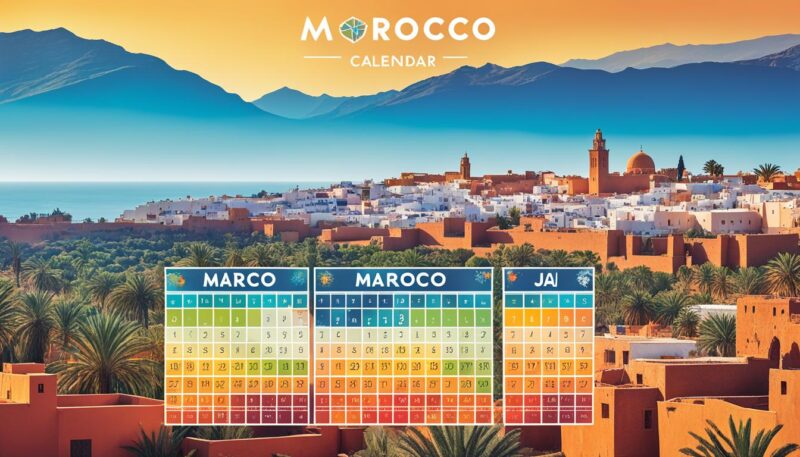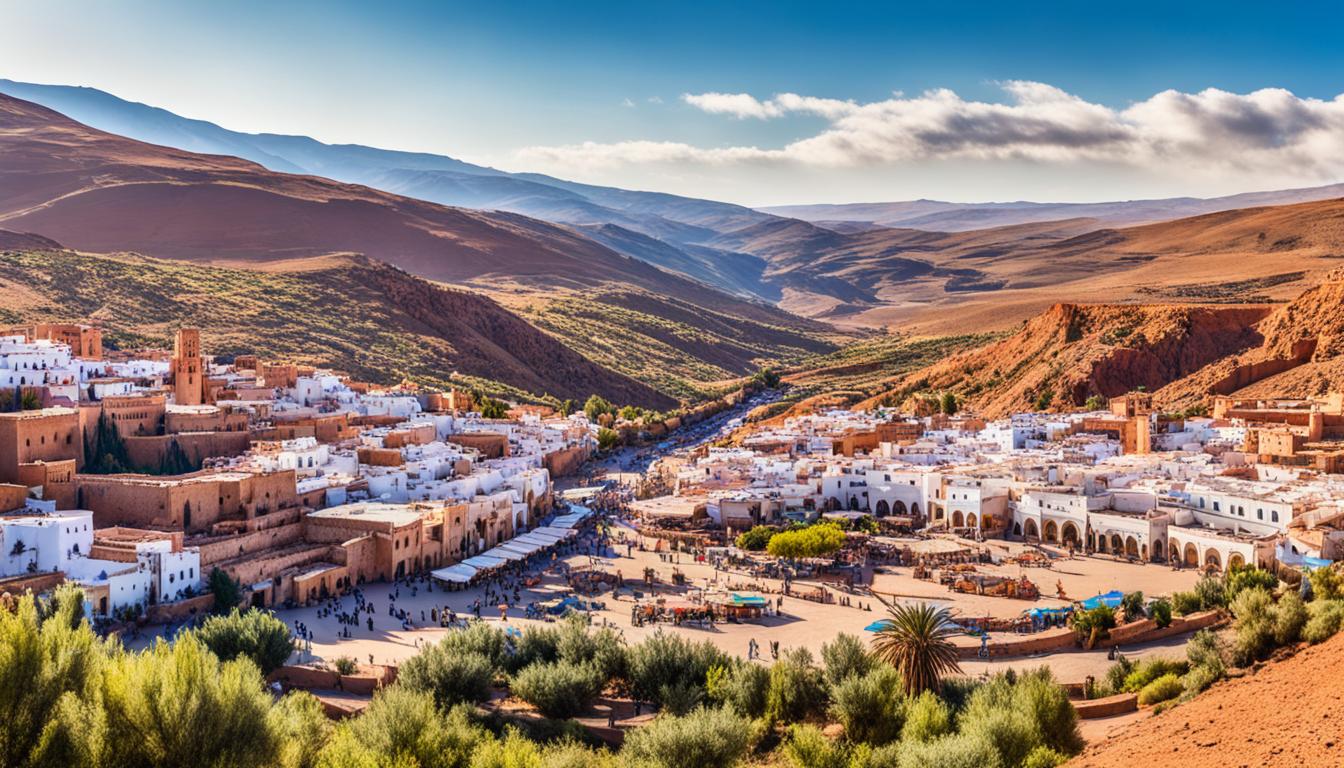Did you know that Morocco is a country of diverse climates, with everything from sunny beaches to snow-capped mountains? Planning the best time to visit this enchanting destination can be a challenge, but fear not! We’ve got you covered with a comprehensive climate guide that will help you make the most of your trip.
Picture this: Sarah has always dreamt of exploring the bustling markets of Marrakech and hiking through the majestic Atlas Mountains. She’s finally booked her tickets and is eagerly counting down the days until her adventure begins. However, as she starts researching the country’s weather patterns, she realizes that her dream trip could turn into a nightmare if she’s not prepared.
Sarah discovers that Morocco experiences extreme weather conditions, from scorching summers to chilly winters. She learns that the best time to visit is during spring or fall, when the weather is warm but pleasant, avoiding the sweltering heat and the bone-chilling cold. These seasons provide the perfect backdrop for her to immerse herself in the vibrant culture, explore ancient cities, and embark on breathtaking hikes.
But Sarah doesn’t stop there. She delves deeper into the climate guide, discovering that the coastal regions offer a year-round escape, with mild winters and inviting temperatures during the summer. The High Atlas Mountains, on the other hand, are ideal for hiking between April and October, with stunning snowy landscapes during the colder months.
As Sarah continues to plan her itinerary, she takes into account the dates of Ramadan, a significant religious observance that affects transportation in Morocco. Armed with knowledge about the country’s climate conditions and cultural events, Sarah can now make informed decisions and create a memorable trip of a lifetime.
Key Takeaways
- The best time to visit Morocco is during spring (mid-March to May) or fall (September to October).
- Coastal regions can be visited year-round, with mild winters and warm summers.
- The High Atlas Mountains are suitable for hiking between April and October.
- Winter brings cold temperatures and stunning snow-covered landscapes.
- Consider the dates of Ramadan when planning transportation.
Monthly Climate Guide for Morocco: Best Time to Visit Each Region

Morocco boasts diverse climate conditions across its various regions, making it a year-round destination for travelers. Understanding the best time to visit each region can enhance your experience and ensure you make the most of your trip.
Marrakech: A City of Endless Charms
Marrakech, known for its vibrant markets and enchanting architecture, is best explored during the spring and fall seasons. During these periods, the temperatures are pleasantly warm, ranging from the low 70s to the mid-80s Fahrenheit. This mild climate allows visitors to comfortably wander through the city’s bustling medinas and experience the rich blend of Moroccan culture.
Essaouira: Coastal Bliss
For those seeking a coastal retreat, Essaouira is a picturesque destination with mild winters and year-round appeal. With temperatures averaging in the mid-60s to low 70s Fahrenheit, Essaouira offers pleasant weather for strolling along the beaches, exploring the historic medina, and immersing yourself in the vibrant arts scene.
Fes: A Journey Through Time
Fes, known for its captivating ancient medina and vibrant cultural heritage, is best visited during the milder seasons of spring and fall. Summers in Fes can be hot, with temperatures reaching the mid-90s Fahrenheit, while winters can be cooler, with temperatures in the mid-50s to low 60s Fahrenheit. Spring and fall offer ideal conditions for exploring Fes’s historical sites, renowned tanneries, and intricate architecture.
Casablanca and Rabat: Coastal Comfort
Located along the Atlantic coast, both Casablanca and Rabat benefit from their position, offering cooler temperatures throughout the year compared to inland areas. With temperatures ranging from the mid-60s to low 70s Fahrenheit, these coastal cities provide a comfortable climate for sightseeing, enjoying the beach, and sampling the local cuisine.
Tangier: A Mediterranean Gem
Tangier, with its unique blend of European and Moroccan influences, enjoys a Mediterranean climate, offering mild winters and warm, breezy summers. With temperatures averaging in the mid-60s to low 70s Fahrenheit, Tangier is ideal for exploring its rich history, vibrant markets, and stunning coastal scenery.
The Atlas Mountains: A Natural Wonderland
The Atlas Mountains, a majestic range that stretches across Morocco, offers an escape from the heat of the lowlands. Spring and fall are the best times to visit this scenic region, as temperatures are pleasant for hiking, with cooler evenings perfect for enjoying the tranquility of the mountainous landscapes.
Understanding the climate conditions in each region of Morocco can help you plan your visit accordingly and tailor your itinerary to make the most of your adventure. Whether you’re exploring the bustling streets of Marrakech, enjoying the coastal breezes in Essaouira, delving into the medieval wonders of Fes, or hiking through the breathtaking Atlas Mountains, Morocco offers a wealth of experiences throughout the year, inviting you to embark on a journey of discovery.
You can aslo read: Best time to visit Mexico
Monthly Temperature and Rainfall Guide for Morocco
Each month in Morocco offers different weather conditions. From the cooler months of January and February with temperatures ranging from 50-68°F to the hotter months of June to early September with temperatures in the high 70s to 100°F, there’s a wide range of climates to consider when planning your trip. Here’s a breakdown of the temperature and rainfall patterns in Morocco:
January
In January, Morocco experiences cooler temperatures ranging from 50-68°F. It’s advisable to pack layers to stay warm, as well as an umbrella or raincoat, as this month sees the possibility of rain and occasional snowfall.
February
In February, temperatures in Morocco remain relatively cool, ranging from 50-68°F. Similar to January, there is still a chance of rain and some snowfall in certain regions.
March to May
March to May brings mild and sunny weather, with temperatures gradually warming up. Average temperatures during these months range from the mid-60s to low 80s°F. It’s a great time to explore Morocco and enjoy outdoor activities.
June to early September

June to early September is considered the hottest period in Morocco, with temperatures ranging from the high 70s to 100°F. If you plan to visit during this time, be prepared for the heat and make sure to stay hydrated and protect your skin from the sun.
October and November
October and November see milder temperatures, making it the perfect time for city exploration and hiking. Temperatures range from the mid-60s to high 70s°F, providing comfortable conditions for outdoor activities.
December
In December, temperatures in Morocco cool down again, ranging from 59-66°F. Although generally milder than the peak summer months, visitors should still pack layered clothing to adapt to varying temperatures.
Rainfall in Morocco is highest during the winter months, particularly in January and February. It’s important to be prepared for rain during these months, especially if you plan outdoor activities. The rest of the year generally experiences little rainfall, making it a great time to explore the diverse landscapes and vibrant cities of Morocco.
| Month | Temperature Range (Fahrenheit) | Rainfall |
|---|---|---|
| January | 50-68°F | Medium |
| February | 50-68°F | Medium |
| March | 55-72°F | Low |
| April | 58-75°F | Low |
| May | 63-81°F | Low |
| June | 70-91°F | Low |
| July | 75-97°F | Low |
| August | 75-99°F | Low |
| September | 70-93°F | Low |
| October | 63-81°F | Low |
| November | 55-72°F | Low |
| December | 59-66°F | Medium |

As you can see from the table and the image above, each month in Morocco offers a unique blend of temperatures and climate conditions. Whether you prefer the cooler months for outdoor adventures or the warmer months for beach getaways, there’s a perfect time to visit Morocco for every traveler.
You can also read: Fiji or Hawaii?
Travel Tips for Visiting Morocco
When traveling to Morocco, it’s essential to keep a few important tips in mind to ensure a smooth and enjoyable experience. From cultural etiquette to visa requirements and safety precautions, here are some key considerations for your trip:
Cultural Sensitivity: Dressing Respectfully
Respecting the local culture is crucial when visiting Morocco, especially in more conservative areas. While Western-style clothing is generally acceptable in cities like Casablanca and Marrakech, it’s recommended to dress more modestly when visiting rural villages or during excursions to the desert or mountains. To show respect, consider wearing lightweight, loose-fitting clothing that covers your shoulders, chest, and knees. This not only demonstrates cultural sensitivity but also helps protect against the sun and heat.
Visa Requirements
Prior to traveling to Morocco, it’s important to check the visa requirements for your specific country of residence. Visitors from the United States, for example, can enter Morocco visa-free for up to 90 days. However, it’s always best to verify the latest visa regulations with the Moroccan embassy or consulate in your home country. Additionally, ensure that your passport is valid for at least six months beyond your planned departure date.
Ensuring Safety
Morocco is generally considered safe for tourists, but it’s essential to take normal precautions and be aware of your surroundings. Here are some safety tips to keep in mind:
- Stay informed about current travel advisories and local customs.
- Travel in groups or with reputable tour operators, especially for excursions into the desert or remote areas.
- Keep your valuables secure and be vigilant in crowded areas.
- Use trusted transportation options, such as registered taxis or reputable car rental services.
- Keep a photocopy of your important travel documents, including your passport, and store them separately from the originals.
By following these travel tips, you can ensure a memorable and enjoyable trip to Morocco. Remember to embrace the rich culture, experience the stunning landscapes, and savor the delicious cuisine for an authentic Moroccan adventure.
Conclusion
When planning a trip to Morocco, choosing the best time to visit depends on personal preferences and the desired activities. Spring and fall offer pleasant weather, making them popular among travelers. However, each season and month in Morocco has its unique charm and attractions, providing a wide range of options for visitors.
Whether it’s experiencing vibrant festivals, exploring bustling cities, trekking in the breathtaking Atlas Mountains, or basking in the warm sun on the beautiful beaches, Morocco has something to offer throughout the year. The diverse climate and rich cultural experiences make it an ideal destination for every traveler.
So, whether you’re dreaming of colorful spring flowers, cozy winter nights by the fireplace, or exciting summer adventures, Morocco is waiting to be explored. Plan your trip according to your individual preferences, and immerse yourself in the captivating beauty and hospitality of this enchanting country.
Discover the best time to visit Morocco and embark on a journey that will leave you with unforgettable memories!
FAQ
What is the best time to visit Morocco?
The best time to visit Morocco is during spring (mid-March to May) or fall (September to October).
What is the weather like in Morocco?
Morocco has diverse climate conditions across its regions. Coastal areas have mild winters and temperatures around the high 70°F in summer. The High Atlas Mountains can be visited all year round, although winter can be cold. Summers are hot but suitable for hiking between April and October.
When is the peak season in Morocco?
The peak season in Morocco is during spring and fall, when the weather is pleasant and ideal for outdoor activities.
When is the off-peak travel time in Morocco?
The off-peak travel times in Morocco are during the winter months (December to February) and the hot summer months (June to August).
What is the climate like in Marrakech?
The best time to visit Marrakech is during spring and fall when the temperatures are pleasant.
What is the climate like in Essaouira?
Essaouira has mild winters and can be visited year-round.
What is the climate like in Fes?
Fes experiences hotter summers and cooler winters, making spring and fall the ideal times to visit.
What is the climate like in Casablanca and Rabat?
Casablanca and Rabat benefit from their coastal positions and have cooler temperatures throughout the year.
What is the climate like in Tangier?
Tangier has a Mediterranean climate.
When is the best time to visit the Atlas Mountains?
The best time to visit the Atlas Mountains is during spring and fall when the weather is refreshing and suitable for trekking.
What are the temperature and rainfall patterns in Morocco?
In January and February, temperatures range from 50-68°F with the possibility of rain and snowfall. March to May brings mild and sunny weather. June to early September are the hottest months, with temperatures in the high 70s to 100°F. October and November see milder temperatures perfect for exploring the cities and hiking. December brings cooler temperatures again, ranging from 59-66°F. Rainfall is highest during the winter months, particularly in January and February.
What should I wear in Morocco?
When visiting Morocco, it’s important to consider the local culture and dress respectfully. Western clothing is generally acceptable in cities like Casablanca and Marrakech, but more traditional clothing may be appreciated in rural villages or during visits to the desert or mountains.
What are the visa requirements for Morocco?
It’s essential to be aware of visa requirements and to check with the embassy or consulate before traveling to Morocco.
Is Morocco safe for tourists?
Morocco is generally considered safe for tourists, but it’s always advisable to take normal precautions and be aware of your surroundings.

